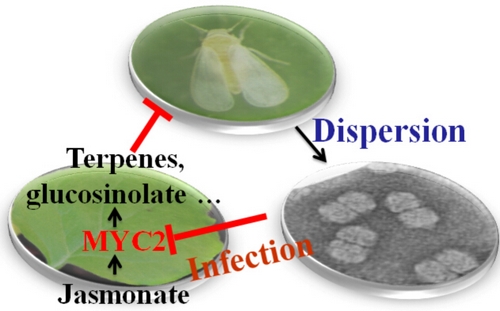
Eighty percent of plant viral pathogens are distributed by insect as disperser. To attract more vectors, pathogens derive various capabilities of modulating host-derived olfactory cues to deceive their vectors.
Whitefly-transmitted geminiviruses have recently emerged as wide-spread destructive pathogens in the past decade. Ecological research identified that geminivirus reduces tobacco jasmonic acid (JA) response and benefits its vector, the whitefly B. tabaci. This results in a vector-virus mutualism. However, the host protein targets of geminivirus and the molecular processes in the suppression of JA signaling are still elusive.
Prof. YE Jian’s group at the Institute of Microbiology of Chinese Academy of Sciences recently unraveled the general mechanism of how begomoviruses suppress plant defense to achieve vector-virus mutualism. The results partially explain why begomoviruses have emerged as serious crop threats all over the world in recent years.
The researchers identified two proteins, βC1 and BV1, of begomovirueses that directly interact with a oncoprotein-like plant transcription factor MYC-like protein 2 (MYC2), a master regulator of the JA pathway. The helix-rich domain of βC1 serves as a structure-mimic of basic helix-loop-helix domain of MYC proteins to heterodimerize with MYC2 protein. The formation of inactive heterodimers compromises activation of terpene synthase genes and glucosinolate genes controlled by MYC2. The results suggest that MYC2 is an evolutionarily conserved target of begomoviruses for suppression of terpene-based resistance to promote vector-virus mutualism.
This work presents a novel scenario of how a pathogen regulates host-derived olfactory cues for vector attraction. The results will also help to address similar tripartite interaction systems in plants, animals and humans and will allow innovative control methods through interference with vector transmission.
The work was supported by the Strategic Priority Research Program Grant from Chinese Academy of Sciences. The results were published in The plant Cell .

To attract more disease vectors for viral transmission, geminivirus targets the plant transcription factor MYC2 to suppress plant terpene-based resistance against whitefly. (Image by Dr. YE's group)

86-10-68597521 (day)
86-10-68597289 (night)

86-10-68511095 (day)
86-10-68512458 (night)

cas_en@cas.cn

52 Sanlihe Rd., Xicheng District,
Beijing, China (100864)

